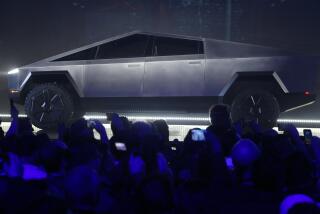COSTA MESA : Students’ Solar Car Passes Test
- Share via
Department of Motor Vehicles inspector John Rooney has seen lots of weird-looking vehicles before, but even he seemed intrigued by the banana-yellow racer that was hauled in by moving van to be registered Friday.
He walked around to the front, crouched near the plane-like nose and asked the driver behind the wheel a few questions.
“Fuel?” he asked, looking at the standard DMV form. “Hmm. Guess it must be sun. They’re going to love that one.”
A smog check was unnecessary.
The solar-powered vehicle, Solaris II, is a project of 10 UC Irvine mechanical engineering seniors who are competing in the annual Tour de Sol, a 234-mile road rally from Vermont to Massachusetts that features solar-powered cars built by college students from around the nation.
The Irvine team is poised to challenge the Massachusetts Institute of Technology, which usually dominates solar racing.
“MIT is the equivalent of General Motors in solar-car racing,” said Edward Fok, 23.
But they can’t put the vehicle on the road until they register it.
The students made an appointment at the Costa Mesa DMV office and, just as if it was any other car, they drove Solaris II around to the inspection station in the back of the building.
The students paced nervously as Rooney looked over the three-wheeled car.
“This is worse than going to the dentist,” said Dixon Kim, 22, as he awaited the decision.
Onlookers and DMV inspectors, perplexed at the cockpit-like canopy jutting out from a flat, 15-foot-long solar panel, stopped, stared and asked the students questions.
Arturo Chavez of Santa Ana watched the event with curiosity.
He had come to the DMV with his brother, who was taking a driving test.
“I think it’s a great idea,” he said of solar-powered cars. “You don’t have to spend money on gas or plugs. . . . “
The solar cells on the panel, which looks a bit like a huge circuit board, convert sunlight into electricity.
“Imagine a gas tank,” Kim said. “The solar panels are providing drops at a time.”
The students are optimistic that the car can reach a speed of 43 m.p.h.
“We’re hoping for more,” Fok said.
The 420-pound car, which looks like a small kayak with a door smashed over it, cost between $30,000 and $40,000 to build.
Its transmission system is designed to moderate the car’s speed so it can operate at peak efficiency without overheating.
It has an accelerator, a steering wheel, a hand brake and two 36-volt batteries to store the electricity.
The students started on the project last summer, modifying a vehicle built by another team of students last year.
And this year’s Solaris II will be converted into next year’s Solaris III, with plans to replace the steel frame with a carbon-fiber composite, the stuff jet fighters are made from.
After about 10 minutes of scrutiny, Rooney signed the form. Some of the students, elated, gave each other high fives. The tension broken, a couple of others raced off to class.
Some said they had been up all night preparing for the registration and would celebrate with some sleep after getting a bite to eat.
Rooney said that because the car has no fenders, bumpers, brake lights or turn signals, it probably wouldn’t be accorded permanent registration. But the DMV would issue a temporary sticker.
But with all the excitement, the students didn’t remember to pick it up. The DMV said Friday they could come and and fetch it, after they paid the fee.
Once they collect the sticker, though, it is still unlikely Solaris II will be seen tooling around local streets.
“I’m sure they would be pulled over,” Rooney said. “I’d like to see the policeman’s face. . . . It’s not like I would see lots of them on the road.”
More to Read
Sign up for Essential California
The most important California stories and recommendations in your inbox every morning.
You may occasionally receive promotional content from the Los Angeles Times.













